National Commemoration Day of Kayyâm
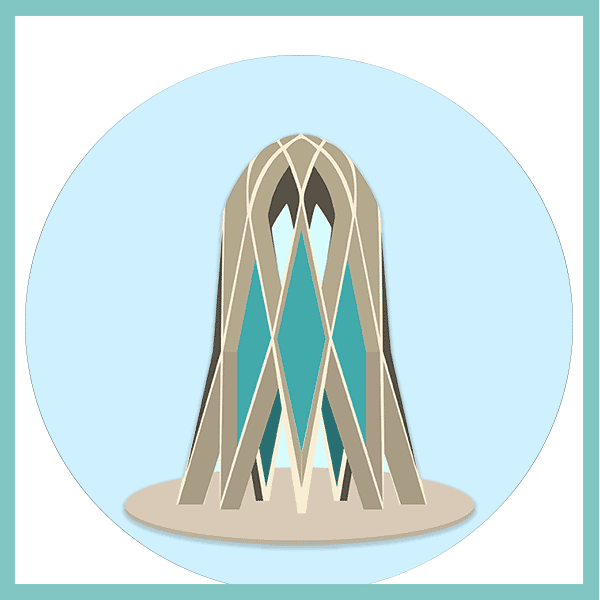
خیام دانشمند
در جَهانِ کُنونی، هِنگامی که نامِ حَکیم عُمَرِ خَیام را مید شِنویم، رُباعیات و شِعرِ او نُخُستین چیزی است که به ذِهنِ ما می آید. اما در حَقیقَت خَیام یکی از پرآوازه ترین دانِشمندان و فیلسوفان و ریاضیدانانِ زمان خود بوده است. خَیام در قَرنِ پنجمِ هِجری در شهر نِیشابور به دُنیا آمد. در آن زَمان، نِیشابور یکی از مُهمترین مَراکزِ عِلمیِ مَنطَقه بود. بیشترِ مَردُمِ این مَنطَقه، پیش از وُرود اِسلام، زَرتُشتی بودند. خیام دورانِ حکومتِ آل بویه و سَلجوقیان را نیز تَجرُبه کرد، در نَتیجه با مَکتب هایِ فِکریِ گوناگون آشنا بود.
Khayyam as a Scientist
In our modern world, when we hear Hakim Omar Khayyam (Xayyâm)’s name, his Rubaiyat is the first thing that comes to our mind. But in his time, Khayyam was a well-known scientist, philosopher, and mathematician. Khayyam was born in the 11th century in Nishapur, one of the main scientific centers of the region. The majority of this region’s population were Zoroastrians before converting to Islam. Khayyam experienced living during the Al-e Buya and the Seljuk dynasty. Thus, he was familiar with different schools of thought.
پَژوهِش هایِ زیادی در زَمینه هایِ مُختَلِفِ ریاضی ازجُمله هِندِسه، جَبر و حِساب اَنجام داد. خیام سوأل هایِ گوناگونی را دَرباره ی خُطوطِ مُوازی، اَعدادِ حقیقی، نِسبیَت، مُعادِله های سه مَجهولی و جَذر بَررِسی کرده بود که می توان آنها را در کتاب هایی که از او به جا مانده یافت.
As a mathematician, Khayyam worked on geometry, algebra, and arithmetic. His studies on parallel lines, angles and triangles, real numbers and proportions, cubic equations, and extraction of the root can be found in his books.
خیام سِتاره شناس نیز بود و به دَستورِ سُلطان مَلک شاه، مأمور شده بود تا رَصَدخانه ای را در اِصفهان بَنا کند. خیام مَسئولِ اِصلاحِ تقویمِ هم شد و این کار را چِنان دقیق و دُرُست اَنجام داد که بعد از یک هِزاره، تَقویمِ ایرانی که یکی از دَقیق ترین تَقویم هایِ جَهان به شٌمار می آید، هَنوز هَم بر گِرِفته از مُحاسِباتِ خیام است.
Khayyam was also an astronomer and was commissioned by Sultan Malik-Shah to build an observatory at Isfahan. One of his other responsibilities was to revise the Persian calendar and he accomplished it in such a precise way that even now, after a millennium, the Iranian calendar, one of the most precise calendars in the world, is based on Khayyam’s calculations.
اما خَیام در کنارِ علوم طَبیعی به فَلسَفه، موسیقی و اَدبیات هم عَلاقه داشته است. او دَرباره ی فَلسفه ی وُجودی اِنسان، تَضادهایِ فَلسَفی و جَبر و اِختیار مُطالِعاتی داشته و کِتاب هایی نیز نوشته است. او موسیقی ایرانی را هم به شِکلِ عِلمی بررسی کرده و روابِطِ ریاضیِ نُت ها و پَرده هایِ موسیقی ایرانی را کَشف کرده بود.
Khayyam was also interested in philosophy, music, and literature. He has studied the philosophy of existence, philosophical contradictions, free will, and determinism and has written some books on these topics. He has also analyzed Iranian music to figure out the mathematical relationships among notes, tetrachords, and musical tones.
دَرون مایه و نَمادهایِ شِعرِ خَیّام
Symbols and Themes of Khayyam’s Poetry
رُباعیات خَیام چِکیده ی مُطالعاتِ فَلسفی، تَضادهای دَرونی، دانِشِ گُسترده و نِگاهِ کُنجکاوِ خیام به جَهان است. از همین رو، شِعرهای خیام فَراتر از زمان خود و به روز هستند. مَفاهیمی مانند «دَم را غَنیمَت شِمُردن» ، «پوچیِ جَهان»، «جَبر و اِختیار»، «آفرینش و مَرگ»، «گَردشِ روزگار» و «شَک در وُجودِ بِهِشت و جَهَنَم» به کَررات در شِعرِ خَیام دیده می شود.
Rubaiyat is a summary of Khayyam’s philosophical studies, conflicts, vast knowledge, and curious glance at the world. Thus, his poetry was progressive and beyond his time. The concepts like “carpe diem”, “absurdism”, “will power and determinism”, “creation and death”, “turning back to the beginning”, and “doubts in the existence of heaven and hell” are repeated themes in his poetry.
یکی از نِمادهایی که خیام در شِعرش اِستفاده کرده است، تَشبیهِ اِنسان به کوزه و تَشبیهِ خالقِ اِنسان به کوزه گَر اَست. کوزه هایِ سُفالی شکننده اند، دُرُست مانندِ انسانِ میرا و بی دِفاع. این تَشبیه، مُختَصِ خَیام اَست، اما او از سایرِ نَمادهای شِعری چون شَراب و مِی، ساقی، شَمع و پَروانه، طبیعت و عناصر طبیعی هم استفاده می کرده است.
Khayyam has repeatedly used jug and potter as symbols for human beings and the creator. The clay jugs are fragile and breakable, like humans who are mortal and defenseless. This metaphor is unique in Khayyam’s poetry, but he used other poetic symbols such as wine, candle and butterfly, nature, and natural elements, too.
جایگاهِ شِعرِ خَیّام دَر اَدَبیات
خیام یکی از بَرجَسته ترین شاعرانِ ایرانی است که مَقبَره اش در نِیشابور روزانه دَهها بازدیدکننده ی عَلاقه مَند به اَدبیات دارد. اَگرچه او هِزار سال پیش در شُمالِ شَرقی ایران زِندگی می کرد، اما امروزه شِعر او در همه جایِ ایران به چِشم می خورد. مَثلاً در شَهری مانندِ بوشِهر در جنوبِ ایران، مَردم شِعرهای او را با موسیقی مَحَلیِ خود تَرکیب کرده اند و مَراسمی به نام خَیام خوانی دارَند. شِعرهای او در آوزهای سُنَتی ایرانی، موسیقی پاپ و حَتی جاز و راکِ ایرانی اِستفاده می شود.
Khayyam’s Place in Literature
Khayyam is one of the most salient Iranian poets whose mausoleum in Nishapur is visited by many literature lovers every day. He used to live in the northeast of Iran almost a thousand years ago, but his poetry has been spread everywhere in Iran. For instance, in Bushehr, a city in the southern part of Iran, people have integrated his poetry with their folk music and created a tradition of Khayyam-Khani, reading Khayyam. His poems are sung in traditional, pop, or even Iranian rock and jazz music.
خیام شهرت جهانی اش را تا حدی مدیون تَرجُمه ی انگلیسی فیتزجرالد از رباعیاتِ است. بعد از اِنتِشارِ این تَرجُمه ها، از سال 1892 گُروهی در لَندن گِردِ هم آمدند و کلابِ خَیام خوانی را راه اَندازی کردند. بَعدتر، شعرهای او به سایرِ زَبان ها تَرجُمه شد و به شُهرتِ خَیام اضافه کرد.
Worldwide, Khayyam owes his fame to Edward FitzGerald’s English translations of Rubaiyat-e Khayyam. In 1892, Khayyam Club was established in London. Later, his Rubaiyat was translated to many other languages and added to his fame.
برای آشنایی با شعرِ خَیام، دو شِعر را برای شما اِنتِخاب کردیم. در رُباعیِ اَول با مَفهوم کوزه آشنا می شوید و می توانید به صِدایِ مُحسِن شَریفیان و موسیقی مَحَلیِ بوشهری گوش دهید. رُباعی دُوم نِمونه ای از واج آرایی در شِعرِ فارسی است که در آن تکرارِ صداهایِ «م» و «ج» شعر را آهنگین تر کرده است. برای این رباعی نیز یک موسیقی پاپ ایرانی، از برادران نَصیری اِنتِخاب شده است.
Here are two Rubais we selected for you. In the first one, you will get familiar with the concept of jug and pottery while listening to a piece of folk Bushehri music by Mohsen Sharifian. The second Rubai is an example of alliteration in which Khayyam has used the “m” and “j” sounds to make the verse more rhythmic. Enjoy listening to a piece of Iranian pop music by the Nasiri brothers while reading the second Rubai.
konj-e xarâb by Soheyl Faqih Nasiri & Basir Faqih Nasiri
afsus ke ‘omr by Mohsen Šarifiyân
Robâ’i no. 117 by Omar Xayyâm
دَر کارگَهِ کوزه گَری رَفتَم دوش
dar kârgah-e kuze(h)gari raftam duš
dar = in
kârgah = workshop
kuze(h)gari = pottery
raftam = I went
duš = last night
دیدم دو هزار کوزه گویا و خَموش
didam do hezar kuze(h) guyâ-o xamuš
didam = I saw
dohezar = two thousand
kuze(h) = jug
guyâ = eloquent
xamuš = silent
ناگاه یِکی کوزه بَرآوَرد خُروش
nâgâh yeki kuze(h) barâvard xoruš
nâgâh = suddenly
yeki = one (of)
kuze(h) = jug
barâvard xoruš = shouted
کو کوزه گَر و کوزه خَر و کوزه فُروش
ku kuzegar-o kuze(h) xar-o kuze(h) foruš
ku = where is
kuzegar = potter
kuze(h) xar = jug buyer
kuze(h) foruš = jug seller
Now try to read Khayyam’s Roba’i
در کارگَه کوزه گَری رفتم دوش
دیدم دو هزار کوزه گویایِ خَموش
ناگاه یِکی کوزه بَرآوَرد خُروش
کو کوزه گَر و کوزه خَر و کوزه فُروش
Robâ’i no. 6 by Omar Xayyâm
Roba’i no 117
Easy Translation:
I went to a pottery workshop last night
Where I saw two thousand jugs speaking in silence
Each one shouting with its language and understanding of the world
Where are the pot maker, the seller, and the buyer?
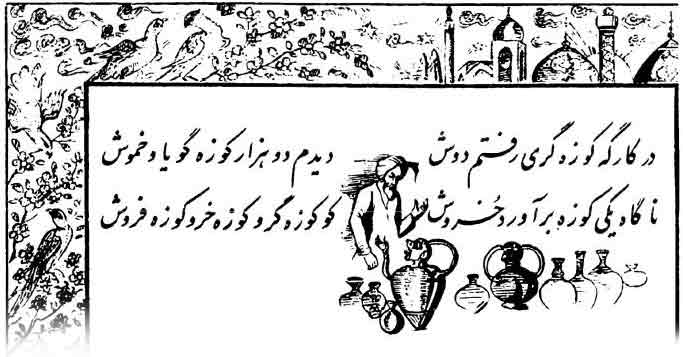
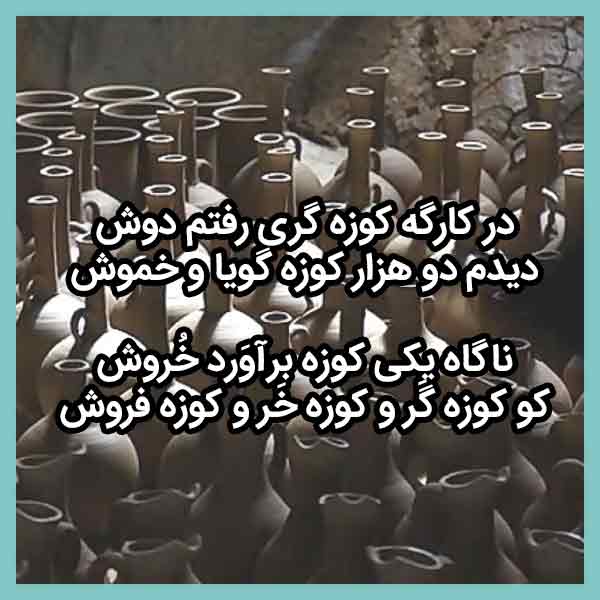
Robâ’i no. 6 by Omar Xayyâm
ماييم و مِى و مُطرِب و اين کُنجِ خَراب
mâyim-o mey-o motreb-o in konj-e xarâb
mâyim = (short form of mâ hastim) = we exist
mey = wine
motreb = musician
in = this
konj = corner
xarâb = ruined, devastated
جان و دِل و جام و جامه پُر دُردِ شَراب
jân-o del-o jam-o jâme(h) por dord-e šarâb
jân= soul
del = heart, feelings
jam = glass, goblet
jâme(h) = clothes, garment
por = full of
dord = lees, wine sediments
šarâb = wine
فارغ ز اُميدِ رَحمَت و بيمِ عَذاب
fareq ze omid-e rahmat-o bim-e azâb
fâreq = disengaged, free
ze = from
omid = hope
rahmat = mercy, redemption
bim = fear, dread
azâb = torment, punishment
آزاد زِ خاک و باد و اَز آتَش و آب
âzâd ze xâk-o bâd-o az âtaš-o âb
âzâd = free
ze = from
xâk = earth
bâd = air
âtaš = fire
âb = water
Now try to read Khayyam’s Roba’i
ماييم و مِى و مُطرِب و اين کُنجِ خَراب
جان و دِل و جام و جامه پُر دُردِ شَراب
فارغ ز اُميدِ رَحمَت و بيمِ عَذاب
آزاد زِ خاک و باد و اَز آتَش و آب
Roba’i no 6
Easy Translation:
Here we are with wine and delightful music in this ruined corner (a metaphor for this world)
Our souls, hearts, goblets, and garments are filled with wine lees
Heedless of hope of redemption or dread of punishment
Free from earth, wind, fire, and water (four elements of nature)
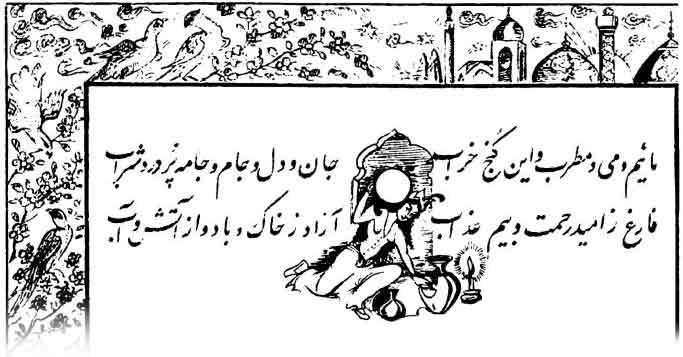

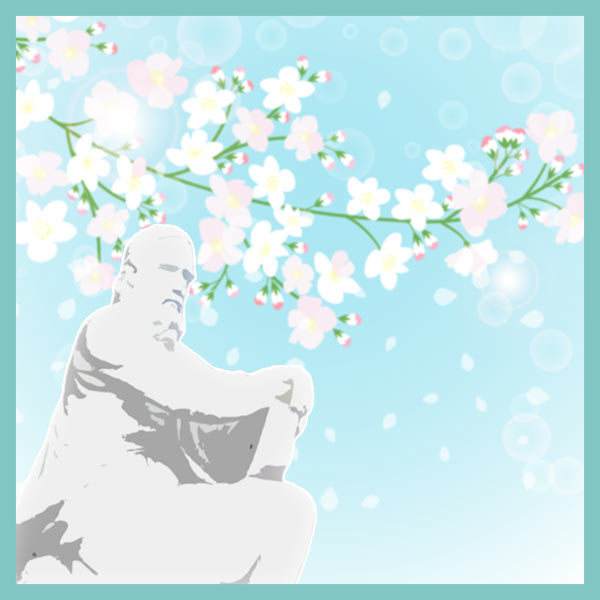
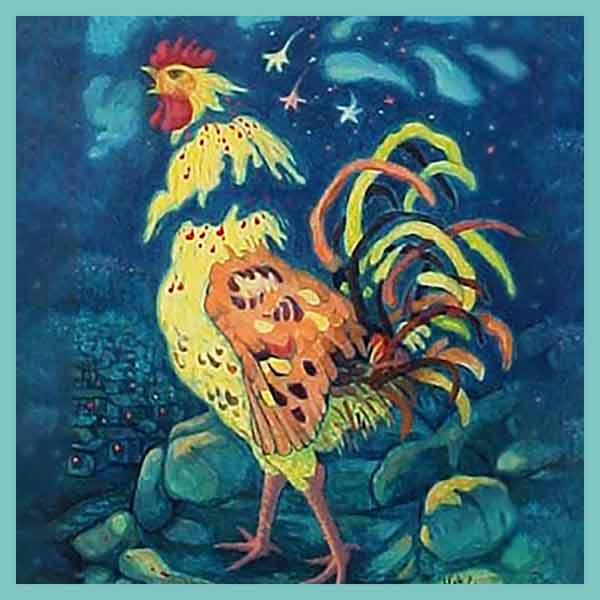

Leave A Comment